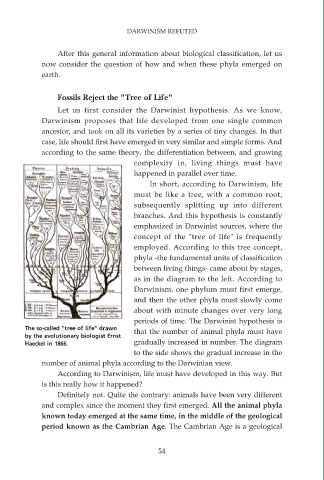Page 56 - Darwinism Refuted
P. 56
DARWINISM REFUTED
After this general information about biological classification, let us
now consider the question of how and when these phyla emerged on
earth.
Fossils Reject the "Tree of Life"
Let us first consider the Darwinist hypothesis. As we know,
Darwinism proposes that life developed from one single common
ancestor, and took on all its varieties by a series of tiny changes. In that
case, life should first have emerged in very similar and simple forms. And
according to the same theory, the differentiation between, and growing
complexity in, living things must have
happened in parallel over time.
In short, according to Darwinism, life
must be like a tree, with a common root,
subsequently splitting up into different
branches. And this hypothesis is constantly
emphasized in Darwinist sources, where the
concept of the "tree of life" is frequently
employed. According to this tree concept,
phyla -the fundamental units of classification
between living things- came about by stages,
as in the diagram to the left. According to
Darwinism, one phylum must first emerge,
and then the other phyla must slowly come
about with minute changes over very long
periods of time. The Darwinist hypothesis is
The so-called "tree of life" drawn that the number of animal phyla must have
by the evolutionary biologist Ernst
Haeckel in 1866. gradually increased in number. The diagram
to the side shows the gradual increase in the
number of animal phyla according to the Darwinian view.
According to Darwinism, life must have developed in this way. But
is this really how it happened?
Definitely not. Quite the contrary: animals have been very different
and complex since the moment they first emerged. All the animal phyla
known today emerged at the same time, in the middle of the geological
period known as the Cambrian Age. The Cambrian Age is a geological
54

